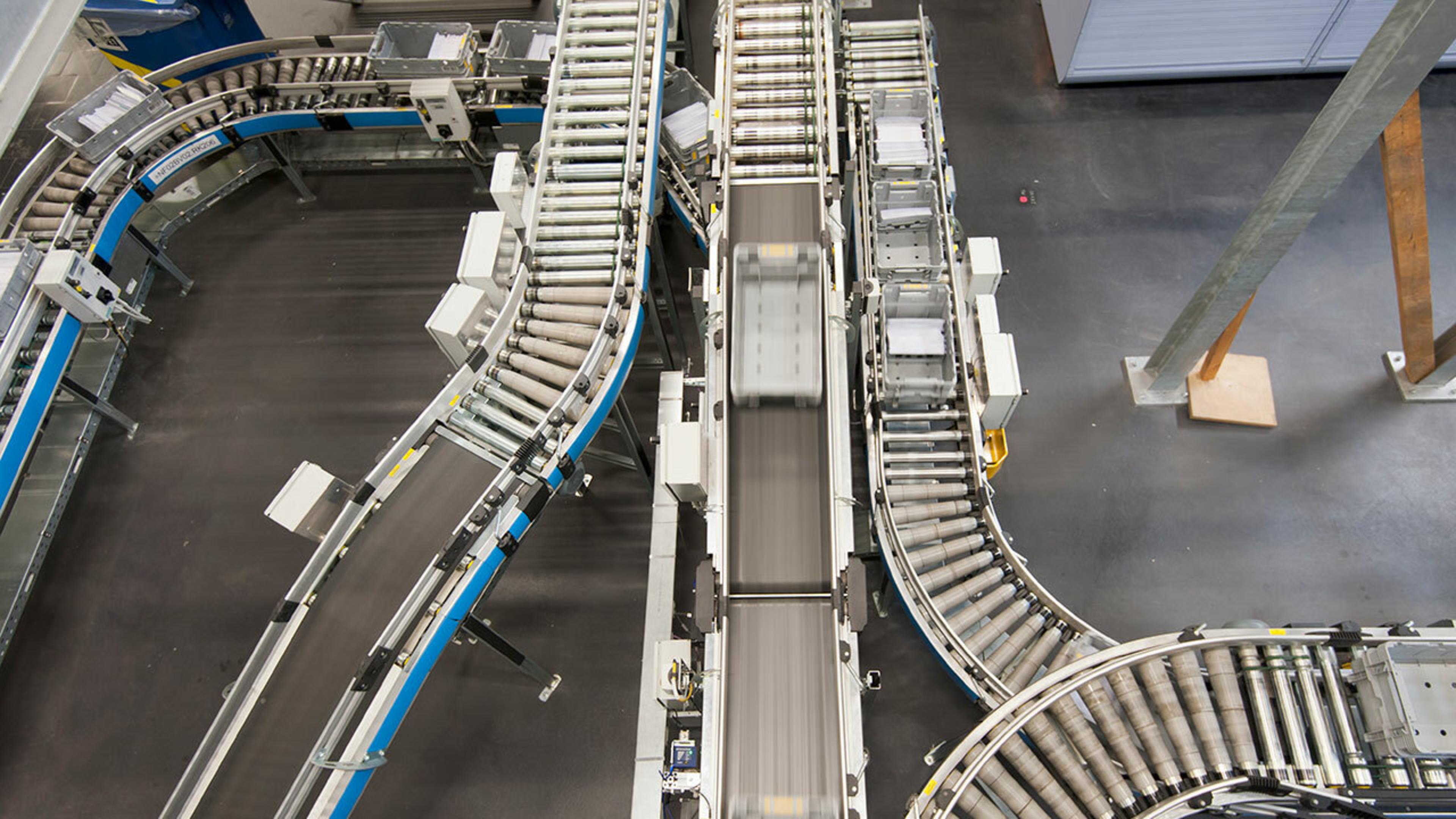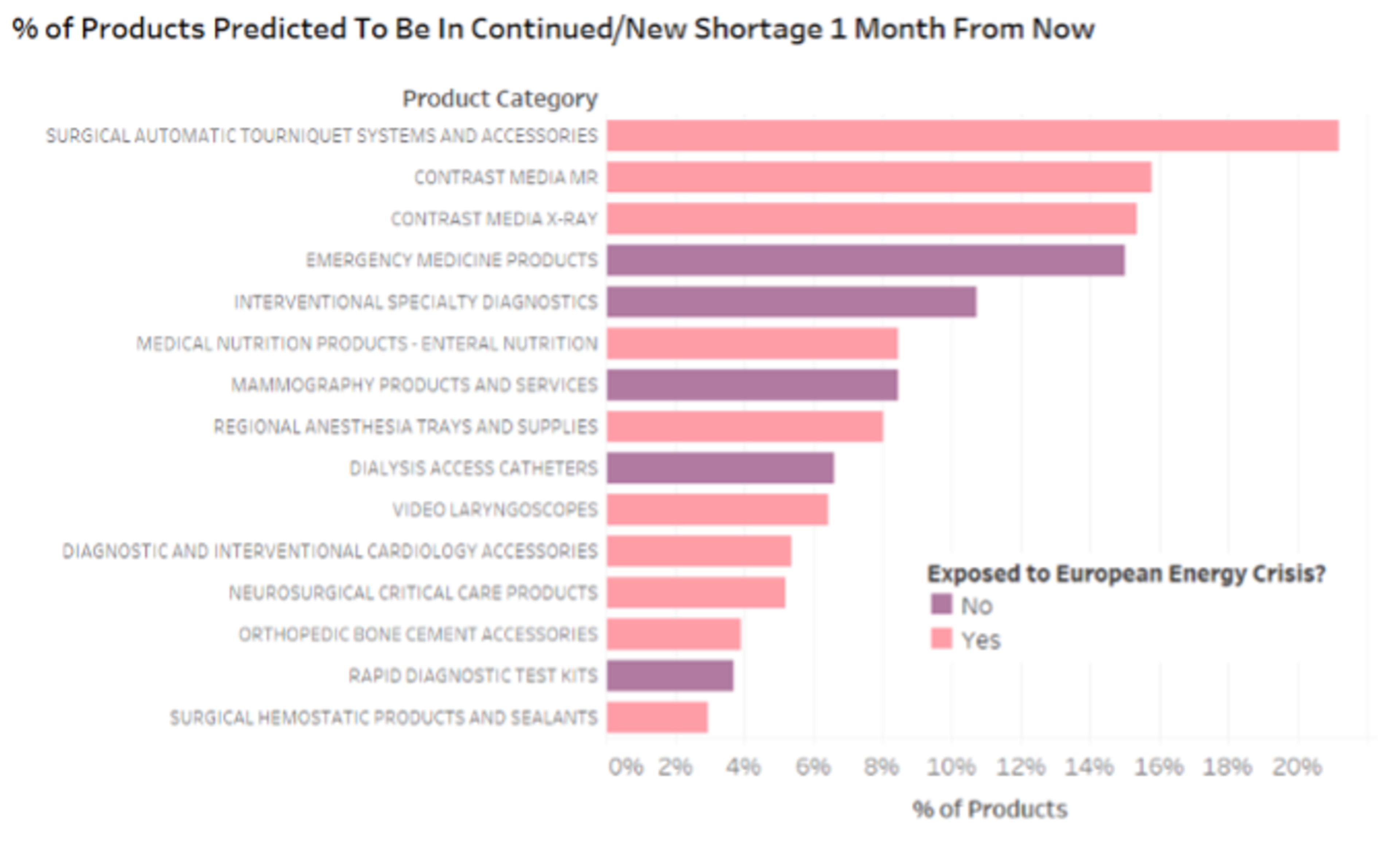PINC AI™ Data: European Energy Crisis Exacerbates Shortage Risks for Healthcare Supplies

Key Takeaways:
- A new PINC AI™ data analysis shows that commonly used hospital supplies across 120 categories are likely to see continued or new shortages one month from now.
- Of the top categories with predicted shortages, many have exposure to energy restrictions in Europe.
- PINC AI™ technology and predictive analytics can help mitigate supply chain risk by pinpointing when specific products are anticipated to become unavailable – helping providers increase preparedness and maintain operations to avoid quality issues or care delays.
Commonly used hospital supplies across 120 categories are likely to experience shortages in the near future, a new PINC AI™ data analysis finds. Most of the affected supplies are necessary to provide routine patient care and shortages may force providers to either identify product alternatives or delay certain procedures.
PINC AI™ data shows the majority of shortages will last a few weeks, moving across products and vendors within a category. PINC AI™ data defines a shortage as products exhibiting lead times of 8-24 days and abnormally high fulfillment times and/or order cancellations. This is roughly the same overall level of shortages that hospitals are currently experiencing, yet the rotation of shortages across individual products, driven by rolling backorders and sporadic delays, can mean new product category issues each week.
Of the top categories with predicted shortages, many have at least some exposure to energy restrictions in Europe, suggesting shortages in these areas could worsen as the crisis unfurls. PINC AI™ analysts identified 300 product categories where at least one primary manufacturer has production in the European Union (EU) and Western Europe – the main regions reliant on Russian gas imports that have been cut off since early September.
While it’s too early to blame the EU energy crisis, 10 of the top 15 shortage-predicted categories one month from now also happen to have some dependence on European manufacturing. For instance, PINC AI™ data predicts that nearly 21 percent of surgical tourniquet systems products and 15 percent of X-ray contrast media remain at high risk of being constrained by shortages one month from now. If manufacturing is impacted by energy conservation in late winter, these shortages could be exacerbated.

Source: PINC AI™ analysis.
The situation remains dynamic as EU officials propose and implement various plans that could mitigate risks, including gas imports from other nations, energy conservation measures, stockpiling of gas and leveraging alternative energy sources. While current weather forecasts are predicting an unusually warm winter for the EU, the region continues to exceed gas storage targets ahead of the winter months in an effort to avoid industry shutdowns and power rationing.
Healthcare Product Shortages = A Moving Target
Global and domestic supply chain disruptions including port congestion, natural disasters, strike threats and the EU energy crisis are creating headwinds and tailwinds that exacerbate existing global pricing, transportation and manufacturing issues.
Alongside workforce and burnout challenges, supply chain teams may feel like they’re constantly chasing a moving target in backorders and product shortages. In a post pandemic environment, PINC AI™ data shows that shortages are largely shifting from multi-year, pervasive issues to an unpredictable set of new challenges every month.
With supply chain leaders and teams facing constantly changing unknowns, innovative solutions – including forecasting technology and predictive analytics – can enable providers’ preparedness, sourcing strategies and long-term resiliency.
Solutions to Target Product Availability and Supply Chain Resiliency
- Historically, hospitals lacked the ability to predict when a product might become short. Backed by machine learning and Premier’s clinical expertise, PINC AI™ technology can help mitigate supply chain risk by pinpointing when the specific products a health system depends on are anticipated to become unavailable. The tool’s predictive capabilities can help providers increase preparedness and maintain operations to avoid quality issues or care delays.
- CognitiveRx® is helping providers pinpoint drug shortages early with 73 percent accuracy using its drug shortages alert model. Using integrated artificial intelligence and machine learning, CognitiveRx® delivers the actionable insights providers need to uncover value, enable preparedness and generate efficiency in the pharmacy supply chain.
- Data is the foundation of risk management and transparency. Strong supplier relationships as well as the largest clinical, operational and financial healthcare database in the nation is enabling PINC AI™ predictive technology capabilities. With supply chain mapping and risk scoring to real-time data on hospital demand and inventory levels, Premier is a clear leader in data for greater disruption prediction, prevention and mitigation. Our data provides visibility into production locations, inventory status and a broader view of the end-to-end supply chain overall.
- With limited suppliers in the market, Premier is providing an alternative product choice to help spark healthy competition and provide a more stable, reliable supply of contrast media for members. In the early spring, the team pursued and implemented a new, expedited supplier contract and gained early access to distribute contrast media to members through the Rapid Commit™ Program. Rapid Commit assists Premier members with short-term supply disruptions and features specific limited-time offers, enabling secured product availability while also driving cost savings.
- Together with some of the nation’s leading health systems, we are creating a more resilient and geographically diverse supply chain. Hundreds of member health systems have stepped up, co-investing alongside Premier to incent U.S. manufacturers, including Prestige Ameritech for N95 respirators and face masks, DeRoyal Industries for isolation gowns, Honeywell for nitrile exam gloves and Exela Pharma Sciences for pharmaceuticals, including some critical shortage drugs. Notably, these efforts prioritize collaborations that leverage existing production capacity, providing a more sustainable approach to U.S.-based production rather than building from the ground up.
- Premier’s Disruption and Disaster Preparedness team is orchestrating efforts required to prepare for and respond to disruptions that impact our nation’s healthcare system. Via a proactive approach and always-on relationships, the team is in continuous communication with global suppliers to ensure safety stock and monitor for risks, with specific focus on products critical to care and categories with unhealthy markets. This team also publishes a weekly product watch list – a ranked list of priority products to help members determine when/if they may need to begin preparing to shift purchasing to alternatives. Unique to Premier and compiled using our purchasing data and member input, the watch list is designed to help with contingency planning, providing advance warning of potential unhealthy markets and connecting members to resources that can help ensure continuity of care.
- Our innovative direct sourcing arm works directly with manufacturers to increase production of necessary medical supplies in the U.S. and globally. This division can also execute forward buys ahead of a shortage situation. As the backbone for our PPE forward buy program, S2S Global delivered more than 166 million masks and respirators and 66 million gowns during the height of the pandemic and continues to serve as a key supplemental source of supply today. Health systems across the nation are leveraging S2S to build resiliency, mitigate risk, increase efficiencies and realize cost savings.
For more on this topic:
- Stay ahead of supply chain shortages. Learn more about how the PINC AI™ Supply Disruption Manager can help you increase preparedness and maintain operations to avoid quality issues or care delays.
- The full October Supply Chain Disruptions Update is available for Premier members in the PINC AI™ Disaster Preparedness and Response community.
- Learn more about Premier and our members’ efforts to build a more resilient supply chain.
- See how Premier's S2S Global is working to create greater diversity in sourcing products, along with long-term resiliency.
Methodology
To determine which categories might be impacted by the European Energy Crisis: Data is collected from participating Premier GPO suppliers, cleansed, de-identified and aggregated to form a database of supplier-reported manufacturing locations by product category. Locations in Western Europe and the EU were tagged, and the percentage of suppliers within each category that had one or more locations in this region was calculated.
To determine which supplies are critical to hospital operations and present the highest risk: Premier clinical SMEs review each category / sub-category of supply and determine whether it is critical to maintaining hospital operations. Supplies that require significant practice change to do without and/or lack suitable alternatives are deemed critical. Premier analyzes purchasing data from >25% of all US acute care providers to determine which categories have two or fewer manufacturers dominating the market (comprising >80% of total market share) and one or less “full line” manufacturers (manufacturers that provide most product types within the category). Categories meeting criteria are deemed high risk.
To predict which categories will have the greatest percentage of products in shortage 3-6 weeks from now: Data is collected from participating Premier member and non-member client health systems, cleansed, de-identified and aggregated to form a collection of hospital ERP data that represents small, medium, and large health systems across 48 of the 50 US states.

Matt has more than 25 years of experience in healthcare project management, strategic supply chain and group purchasing. Matt is part of the team that develops and implements support applications for Premier’s supply chain solutions, helping design and build supply chain/clinical data resource utilization, P2P commerce and core analytics solutions.

Matt leads Premier’s Advanced Business Intelligence (ABI) platform, a curated set of data and technology that enables Premier members to make supply chains more efficient and resilient. Matt and team meet Premier’s clients where they are, providing fully managed solutions as well as highly flexible self-service capabilities. On this same platform, the ABI team also helps bring forth useful insights in the data by looking for trends across thousands of unique healthcare facilities.

David leads the company’s core supply chain business, including sourcing, contract management, operations and business analytics. He also provides executive leadership for the Premier direct sourcing business.
Article Information

Matt has more than 25 years of experience in healthcare project management, strategic supply chain and group purchasing. Matt is part of the team that develops and implements support applications for Premier’s supply chain solutions, helping design and build supply chain/clinical data resource utilization, P2P commerce and core analytics solutions.

Matt leads Premier’s Advanced Business Intelligence (ABI) platform, a curated set of data and technology that enables Premier members to make supply chains more efficient and resilient. Matt and team meet Premier’s clients where they are, providing fully managed solutions as well as highly flexible self-service capabilities. On this same platform, the ABI team also helps bring forth useful insights in the data by looking for trends across thousands of unique healthcare facilities.

David leads the company’s core supply chain business, including sourcing, contract management, operations and business analytics. He also provides executive leadership for the Premier direct sourcing business.